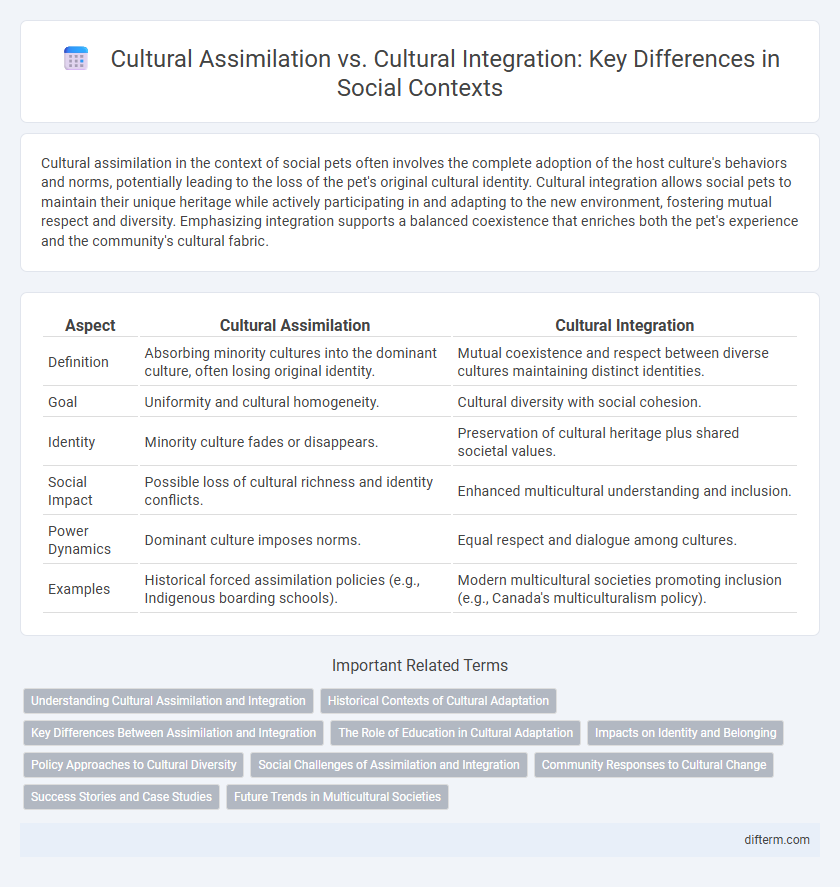Cultural assimilation in the context of social pets often involves the complete adoption of the host culture's behaviors and norms, potentially leading to the loss of the pet's original cultural identity. Cultural integration allows social pets to maintain their unique heritage while actively participating in and adapting to the new environment, fostering mutual respect and diversity. Emphasizing integration supports a balanced coexistence that enriches both the pet's experience and the community's cultural fabric.
Table of Comparison
| Aspect | Cultural Assimilation | Cultural Integration |
|---|---|---|
| Definition | Absorbing minority cultures into the dominant culture, often losing original identity. | Mutual coexistence and respect between diverse cultures maintaining distinct identities. |
| Goal | Uniformity and cultural homogeneity. | Cultural diversity with social cohesion. |
| Identity | Minority culture fades or disappears. | Preservation of cultural heritage plus shared societal values. |
| Social Impact | Possible loss of cultural richness and identity conflicts. | Enhanced multicultural understanding and inclusion. |
| Power Dynamics | Dominant culture imposes norms. | Equal respect and dialogue among cultures. |
| Examples | Historical forced assimilation policies (e.g., Indigenous boarding schools). | Modern multicultural societies promoting inclusion (e.g., Canada's multiculturalism policy). |
Understanding Cultural Assimilation and Integration
Cultural assimilation involves the process whereby individuals or groups adopt the dominant culture's traits, often leading to the loss of original cultural identity. In contrast, cultural integration allows individuals to maintain their unique cultural identities while participating fully in the larger society. Understanding these concepts is essential for fostering inclusive social environments that respect diversity while promoting social cohesion.
Historical Contexts of Cultural Adaptation
Historical contexts of cultural adaptation reveal that cultural assimilation often entailed the absorption of minority groups into a dominant culture, frequently erasing original identities and traditions. In contrast, cultural integration allowed for the coexistence and mutual respect of diverse cultural expressions within societies, preserving heritage while fostering social cohesion. Key examples include the forced assimilation policies toward Indigenous peoples in North America versus the multicultural policies adopted in post-colonial nations like Canada and Australia.
Key Differences Between Assimilation and Integration
Cultural assimilation involves minority groups fully adopting the dominant culture, often leading to the loss of their original cultural identity, while cultural integration allows individuals to maintain distinct cultural identities within a shared society. Assimilation emphasizes conformity and uniformity, whereas integration promotes diversity and mutual respect among cultural groups. Key differences include the extent of cultural retention and the social dynamics between dominant and minority populations.
The Role of Education in Cultural Adaptation
Education plays a pivotal role in cultural adaptation by fostering cultural integration, where diverse cultural identities coexist while maintaining mutual respect and understanding. Unlike cultural assimilation, which often requires individuals to abandon their original cultural traits, educational programs promoting cultural integration encourage the preservation of heritage alongside learning societal norms. Schools incorporating multicultural curricula and inclusive teaching practices directly contribute to social cohesion and the development of intercultural competence.
Impacts on Identity and Belonging
Cultural assimilation often leads to the erosion of original identity as individuals adopt the dominant culture's norms and values, risking the loss of unique cultural heritage. In contrast, cultural integration allows for the coexistence of diverse identities, fostering a sense of belonging without requiring the abandonment of one's cultural roots. These differing approaches significantly influence personal and collective identity formation, affecting social cohesion and inclusive community development.
Policy Approaches to Cultural Diversity
Policy approaches to cultural diversity often distinguish between cultural assimilation, which promotes the absorption of minority groups into the dominant culture, and cultural integration, which encourages maintaining distinct cultural identities while fostering social cohesion. Assimilation policies prioritize uniformity and may lead to the erosion of minority traditions, whereas integration policies support pluralism and mutual respect among diverse cultural groups. Effective frameworks for managing cultural diversity emphasize inclusive strategies that balance cultural preservation with participation in the broader society.
Social Challenges of Assimilation and Integration
Cultural assimilation often leads to social challenges such as loss of identity, marginalization, and psychological stress due to pressure to conform to dominant norms. In contrast, cultural integration promotes mutual respect and coexistence but faces obstacles like social segregation, discrimination, and unequal access to resources. Both processes require addressing issues of social inclusion, language barriers, and community support systems to foster harmonious multicultural societies.
Community Responses to Cultural Change
Community responses to cultural change often vary between cultural assimilation and cultural integration, reflecting differing approaches to diversity. Cultural assimilation involves the absorption of minority cultures into the dominant society, leading to the loss of distinct cultural identities and traditions. Cultural integration promotes mutual respect and coexistence, allowing diverse communities to maintain their unique cultural practices while participating fully in the larger society.
Success Stories and Case Studies
Case studies highlight that cultural integration fosters mutual respect and societal cohesion by encouraging diverse groups to maintain their unique identities while participating equally in social institutions. Success stories from multicultural cities like Toronto demonstrate improved economic outcomes and reduced social tensions through inclusive policies promoting cultural exchange and community engagement. Research indicates that integration strategies outperform assimilation by enhancing both individual well-being and collective social capital.
Future Trends in Multicultural Societies
Future trends in multicultural societies emphasize cultural integration, where diverse groups maintain distinct traditions while participating equally in social, economic, and political life. Cultural assimilation, often involving the loss of original cultural identities, is increasingly viewed as less sustainable amid growing global interconnectedness and digital communication. Advances in inclusive policies and intercultural dialogue promote harmonious coexistence and mutual respect, shaping more resilient and adaptable communities.
cultural assimilation vs cultural integration Infographic

 difterm.com
difterm.com